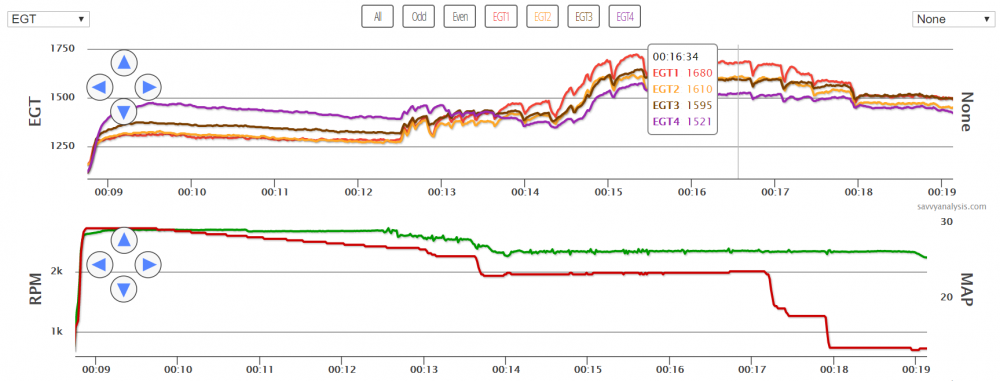-
Posts
3,541 -
Joined
-
Last visited
-
Days Won
13
Content Type
Profiles
Forums
Blogs
Gallery
Downloads
Media Demo
Events
Everything posted by DXB
-
https://dailytimes.com/promotions/article_f44f402c-153a-11ea-960f-3b4021e27776.html?fbclid=IwAR2jgxRhV5oS9S5Z7nwoW5-zKWTY7tayZ5Bc5uKNEQTdy_XzP85zymY4ZKI "Negotiations ongoing with 'additional investor'" Hopefully an investor who also brings clear long term vision, industry knowledge, and management expertise to the table....
-
That great! But WTF happened??
-
Or coveting your copilot's slaves, ox, or donkey, or something like that...
-

Help - Stranded after mag failure (?) in Myrtle Beach
DXB replied to DXB's topic in General Mooney Talk
Anthony it's the left mag that's bad (proven after landing). My mag check order on runup is LEFT-BOTH-RIGHT-BOTH. So it is the RIGHT #1(bottom plug) that has a hotter EGT at runup. It ran smooth at runup on both sides before the flight despite that observation. Cyl #1 has run hotter EGTs typically ever since that cylinder got changed to a new one 2 years ago. I think it is a red herring. I changed the plugs to new 50 hours ago (BYL-nosed Tempests). Changing to new plugs did not alter this behavior for #1. I interpret those downward spikes in the EGT trace as briefly getting ignition on both plugs, not the mag cutting out. Note the blazing hot EGT baseline above those downward spikes (gets up to 1700 for #1) - that's clearly ignition happening on just the right mag. -

Help - Stranded after mag failure (?) in Myrtle Beach
DXB replied to DXB's topic in General Mooney Talk
Thanks very much Alan - Savvy Breakdown Assistance is already working with a local shop to look at it on Monday - let me see what transpires. -

Help - Stranded after mag failure (?) in Myrtle Beach
DXB replied to DXB's topic in General Mooney Talk
Based on the EGT trace, it looks like the left mag gave up suddenly, but was still firing briefly every ~500 revolutions - the down spikes in EGT reduce proportionately with rpm when I went from 2700 to 2300 rpm. That low rate of firing was enough to make it run rough and also make the governor unstable at high power. The combustion disturbance from that mag then abates when I reduced MP to descend back to the field. In retrospect, it would have run smooth had I switched to the right mag, which would have also controlled my heart rate and blood pressure before returning to the field. Of course it would have died when I switched to the left, then backfired when I went to right or both, unless I had the presence of mind to pull mixture out before switching again, which is not likely. That would have had decidedly the opposite effect on my heart rate, which would be interesting for engine monitors to capture in conjunction with these events . -
So then you're compensating for a small Johnson bar using an IO-720-A1A ?
-
It's a little skinny and small compared to a Vintage Mooney Johnson. I guess there are those who say size doesn't matter.
-

Help - Stranded after mag failure (?) in Myrtle Beach
DXB replied to DXB's topic in General Mooney Talk
Then would the retard breaker points stop functioning at the exact same moment as the main ones (i.e. after landing it wouldn’t start until key released to “both”)? Sorry if it’s an obtuse question - my grasp of inner magneto workings is tenuous. -

Help - Stranded after mag failure (?) in Myrtle Beach
DXB replied to DXB's topic in General Mooney Talk
I had the FP issue looked at ad nauseam when I first got the plane 700 hours ago and discussed extensively on here (multiple prior threads). The reading occasionally goes much lower than the 1.8 psi shown here - even below the 0.5psi redline occasionally, but fuel flow never drops (all that really matters). Other folks with carb'd birds have described the same phenomenon. My working conclusion was that there is vapor lock from time to time in the fuel line that goes to the pressure transducer, preventing an accurate pressure reading. Regardless, it's definitely not the problem here. Addendum: Here's one old thread - not sure it's the best one. -

Help - Stranded after mag failure (?) in Myrtle Beach
DXB replied to DXB's topic in General Mooney Talk
Pressure drops to 1.8psi (0.5 is red line for this carb'd engine) when boost pump turned off at WOT in climb - that's normal -happens most every flight. Note fuel flow hardly budges when that happens. So it's definitely spark and not fuel. All 4 EGTs are effected. Left mag check afterwards is abnormal on ground - it essentially dies. I can't be sure it's the mag itself, but it's definitely the left ignition system and affects all 4 cylinders. -

Help - Stranded after mag failure (?) in Myrtle Beach
DXB replied to DXB's topic in General Mooney Talk
Thanks- that crossed my mind as well - unfortunately the Sureflys are on backorder - mine is supposed to ship on the 12th. I’d have to get lucky with a mechanic around here having one on hand. Also I have a bendix so need to swap to the Slick harness for a Surefly. -

Help - Stranded after mag failure (?) in Myrtle Beach
DXB replied to DXB's topic in General Mooney Talk
The mags just past 500hrs, and I was actually about to replace the left with a Surefly and IRAN the right one at annual at your home field next month. Sure would have been cheaper if it had held out a couple more weeks -

Help - Stranded after mag failure (?) in Myrtle Beach
DXB replied to DXB's topic in General Mooney Talk
Yeah I thought about doing an inflight mag check but was a little rattled, and I was making decent power still so didn’t feel like messing with anything and just getting on the ground. The runup before takeoff looks pretty unremarkable on the posted trace, except maybe weaker ignition on #1 on the right - EGT rise on L and R are otherwise very symmetric. I did the ground runup after the flight leaned out and left was almost dead. Should have tried it rich as well. -
Some stress today when climbing out from KCRE at Myrtle Beach, which of course does not have a maintenance shop. Savvy Breakdown Assistance is helping (this is a nice benefit of Global Insurance BTW), and I'm flying home commercial. Here's the scenario: I am climbing out through ~2500ft and notice sudden roughness and see fluctuating RPM (I initially think the governor is croaking). I level off and reduce power to 2300 squared, but the roughness is no better, and rpm does not stabilize. I see EGTs rising rapidly and fluctuating on all 4 cylinders. Running rich or lean seems to make no difference. I return immediately for a precautionary landing, and it runs smooth after reducing power to descend. Here's the Savvy Analysis trace: https://apps.savvyaviation.com/flights/3608725/8c7f423a-f1f2-41d7-8687-54a3fc328354 EGTs on all 4 cylinders are affected, so its seems like it's a mag. So after landing and looking at this, I did a ground runup at 1700rpm with it leaned, and the right side runs smooth, the left side is almost dead but not quite (?) - it's getting maybe just a little ignition but not enough to prevent a backfire upon going back to "Both." I also got no ignition when trying to start until I stopped cranking -again pointing at the left mag. After shutdown, I shook the left mag with my hand, and it does not seem obviously loose. My question - could this be anything besides the left mag itself? Ignition switch? Field wire or something? I'm not too sharp on this electrical stuff... Ironically the mags are just past 500 hrs and I was getting ready to replace the left mag with a Surefly at annual next month .
-
Is this a scammer? Anyone get similar messages? I posted a WTB for a '68C seat back and got this note from someone with no posts who joined very recently and refers me to an email for someone who has "a for sale". No reply when I ask for further detail, so no way I'm gonna pursue the contact provided. I just wondered if people were getting similar messages. And if the person turns out to be legit, then apologies in advance
-
This is a vast exaggeration , though admittedly Bonanzas do seem to have an edge on control feel in my very brief experience. But with essentially all my time in a Mooney, the V36 Bo seating position felt a little odd - more like sitting at a kitchen table than in a cockpit. But Bonanza and Mooney owners should no longer be divided by such issues and instead stay focused on denigrating Cirrus .
-
A fitting tribute to your friend - very sorry for your loss!!
-
A 2000 SR20 Cirrus is objectively a good airplane with various strengths and weaknesses relative to the M20J model. But let's be honest - I doubt any of us, including owners of the pre J models, would enjoy flying the Cirrus nearly as much, or even want to be seen in one . The control feel in the Mooney is just in another league.
-

Fatal Cirrus accident last night in Vegas
DXB replied to kerry's topic in Mooney Safety & Accident Discussion
I doubt any experienced person would say you were being difficult Getting within 10 mi of a major T-storm is too close for me - best deviate while still VMC. An approach I used in a similar situation was to "request immediate deviation to avoid convective activity" with deliberate strain in my voice, along with asking for exactly what I want - that worked. My next step might have been exactly as you did. But since I had no easy way out in VMC, it might actually been time for the "E" word instead. -

Fatal Cirrus accident last night in Vegas
DXB replied to kerry's topic in Mooney Safety & Accident Discussion
My own monday morning quarterback of this scenario is as follows: When the pilot of the emergency aircraft couldn't easily climb to the MVA, he would have been better using on board terrain avoidance tools on a moving map (as simple as foreflight + portable receiver if need be) to get back to the airport rather than continue to accept vectors. Agree the approach controller's handling sounds pretty reasonable. No question this tragedy reminds us all to be attentive to terrain avoidance using the excellent tools now available, whether it's VFR on a dark night or in IMC in the system. I still gotta wonder what happened on the controller side that led to someone being assigned a heading and altitude that takes them into a mountainside within a class B airspace. That level of mistake seems pretty rare in this day and age. -
The Element extinguisher seems like it's truly an innovation from the standpoint of effectiveness, weight, nontoxicity, non-corrosiveness, compact form factor, and particularly ease of use. Anyone want to buy my 1211 Halon extinguisher? (only half kidding).
-
I'd take this option if it were available. Based on my currently ingrained habits, forgetting to make sure the gear is down and locked in my J bar mooney seems like a pretty far off possibility (although of course folks continue to prove that it isn't). Unfortunately I doubt any insurer would be willing to divide their risk pool this way. But if they are, maybe I could get another 33% off by agreeing never to go anywhere near a Boeing 737 Max again?
-

Fatal Cirrus accident last night in Vegas
DXB replied to kerry's topic in Mooney Safety & Accident Discussion
Ugh what a tragedy. He presumably was assigned 6500 on a vector while vfr. The crash site is at 6600ft. That 6900 peak is still just inside the Vegas Bravo. What happened from the pilot side might be inferred even with the very limited info. It will be interesting to learn about the contributing factors on the ATC side. -
Wow this guidance is contrary to much advice I’ve received: to run at very low rpm for several seconds on initial startup, particularly at cold temps, to limit damage while oil distributes. The downside per this article would be poor ring sealing, so more toxic corrosive blowby in the oil, and poor lead scavenging causing more deposits due to the slow warmup. I will say that I have to taxi at the absolute minimum rpm possible at busy fields in the summer to limit CHTs on takeoff, and I am very hesitant to stop doing that. Otherwise I’m really not sure now what the best approach is






